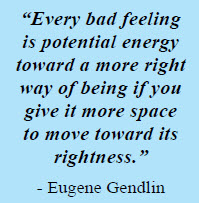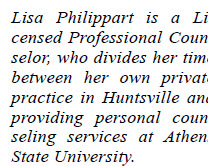Felt Sense
 By: Lisa Philippart
By: Lisa Philippart
I recently experienced an extremely challenging and hurtful event. As I was processing what happened, my therapist friend shared with me a concept that I had never heard of before, but which perfectly described the feelings and sensations I was experiencing. The term is Felt Sense, and it is difficult to explain. Felt sense describes the internal bodily awareness that arises from the mind’s increased awareness. Philosopher Eugene Gendlin originally developed the idea of a felt sense, which functions as the connection between the mind and the body. People experiencing a felt sense feel more in tune with their body and bodily processes, and often even feel as if they can feel themselves within their stomach or chest. Gendlin characterized the felt sense as a combination of emotion, awareness, intuitiveness, and embodiment. It is often unclear because people can’t specifically verbalize what they are feeling. In my case, it was a vague awareness of an old psychological trauma. However, a positive felt sense could lead to the development of innovative ideas.


Neuroscience of the cerebral hemisphere suggests that whole body “knowing” is first felt and sensed in the right hemisphere as a vague implicit awareness. This kind of knowing is bodily felt and slow to form. As it is sensed directly and felt within, our experiencing carries over or connects with the left hemisphere processing, which controls symbol formation and expression (words, comparisons, gestures, and images.) We have all had the experience of struggling to find the right words or way to express something. I know I have said something and immediately known that it sort of fits, but still doesn’t feel right. When the right word does come, there is a bodily relief, almost like a shift in how the situation is perceived. Felt sense is therefore a freshly formed, whole-body sense of a situation that has a more-than-words-can-say quality to it. When our sweet dog, Dexter, died…. speaking from a felt sense…it felt like a pallet of bricks had been placed on my chest, on top of my broken heart.
Speaking from a felt sense presents in several ways:

1. Groping for words and then giving up, sometimes saying, “I just don’t know how to say this.”
2. Using words like “kind of” or “similar to.”
3. Gesturing or focusing on the middle of the body.
4. Becoming quiet or looking down to attend to inner expression.
Felt senses take time to form. This process of becoming is experienced in the present moment and is about a life situation that contains more implicit sensations than had been previously known. Because felt senses are so difficult to describe from a cognitive perspective, we often have to resort to using metaphors to share what we’ve experienced in a bodily way. When we ask inside, “How was that occurrence for me physically,” we do not discover what was already there, but rather we open ourselves to focus on something new about to take place. When we make this connection of felt sense, an intricate whole that sums up, captures, includes, and contains all aspects of the incident is able to emerge. Next time, we will look at the therapy of felt sense: Focusing.
By: Lisa Philippart
Licensed Professional Counselor